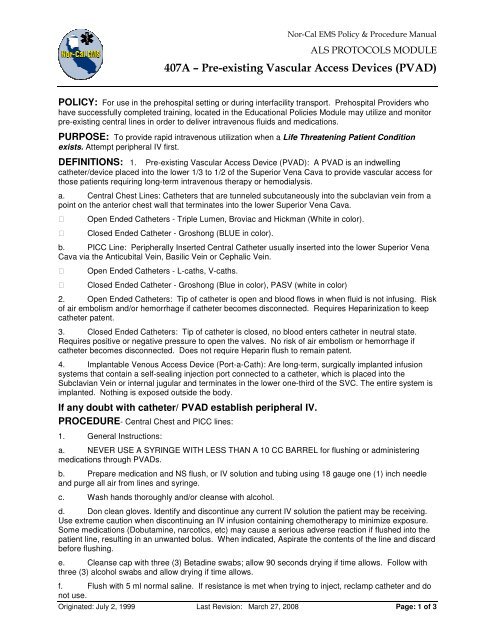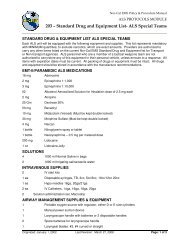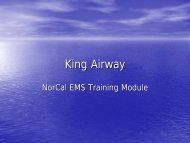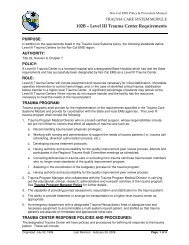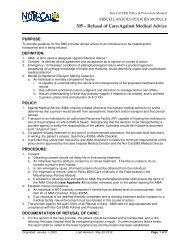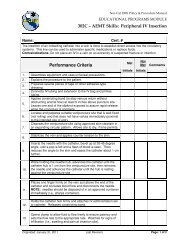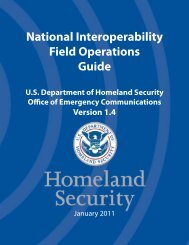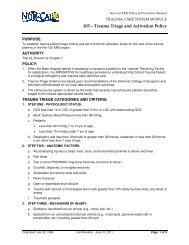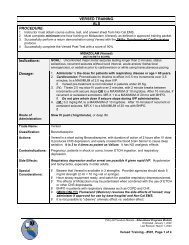407A – Pre-existing Vascular Access Devices (PVAD)
407A – Pre-existing Vascular Access Devices (PVAD)
407A – Pre-existing Vascular Access Devices (PVAD)
You also want an ePaper? Increase the reach of your titles
YUMPU automatically turns print PDFs into web optimized ePapers that Google loves.
Nor-Cal EMS Policy & Procedure ManualALS PROTOCOLS MODULE<strong>407A</strong> <strong>–</strong> <strong>Pre</strong>-<strong>existing</strong> <strong>Vascular</strong> <strong>Access</strong> <strong>Devices</strong> (<strong>PVAD</strong>)POLICY: For use in the prehospital setting or during interfacility transport. <strong>Pre</strong>hospital Providers whohave successfully completed training, located in the Educational Policies Module may utilize and monitorpre-<strong>existing</strong> central lines in order to deliver intravenous fluids and medications.PURPOSE: To provide rapid intravenous utilization when a Life Threatening Patient Conditionexists. Attempt peripheral IV first.DEFINITIONS: 1.<strong>Pre</strong>-<strong>existing</strong> <strong>Vascular</strong> <strong>Access</strong> Device (<strong>PVAD</strong>): A <strong>PVAD</strong> is an indwellingcatheter/device placed into the lower 1/3 to 1/2 of the Superior Vena Cava to provide vascular access forthose patients requiring long-term intravenous therapy or hemodialysis.a. Central Chest Lines: Catheters that are tunneled subcutaneously into the subclavian vein from apoint on the anterior chest wall that terminates into the lower Superior Vena Cava.Open Ended Catheters - Triple Lumen, Broviac and Hickman (White in color).Closed Ended Catheter - Groshong (BLUE in color).b. PICC Line: Peripherally Inserted Central Catheter usually inserted into the lower Superior VenaCava via the Anticubital Vein, Basilic Vein or Cephalic Vein.Open Ended Catheters - L-caths, V-caths.Closed Ended Catheter - Groshong (Blue in color), PASV (white in color)2. Open Ended Catheters: Tip of catheter is open and blood flows in when fluid is not infusing. Riskof air embolism and/or hemorrhage if catheter becomes disconnected. Requires Heparinization to keepcatheter patent.3. Closed Ended Catheters: Tip of catheter is closed, no blood enters catheter in neutral state.Requires positive or negative pressure to open the valves. No risk of air embolism or hemorrhage ifcatheter becomes disconnected. Does not require Heparin flush to remain patent.4. Implantable Venous <strong>Access</strong> Device (Port-a-Cath): Are long-term, surgically implanted infusionsystems that contain a self-sealing injection port connected to a catheter, which is placed into theSubclavian Vein or internal jugular and terminates in the lower one-third of the SVC. The entire system isimplanted. Nothing is exposed outside the body.If any doubt with catheter/ <strong>PVAD</strong> establish peripheral IV.PROCEDURE- Central Chest and PICC lines:1. General Instructions:a. NEVER USE A SYRINGE WITH LESS THAN A 10 CC BARREL for flushing or administeringmedications through <strong>PVAD</strong>s.b. <strong>Pre</strong>pare medication and NS flush, or IV solution and tubing using 18 gauge one (1) inch needleand purge all air from lines and syringe.c. Wash hands thoroughly and/or cleanse with alcohol.d. Don clean gloves. Identify and discontinue any current IV solution the patient may be receiving.Use extreme caution when discontinuing an IV infusion containing chemotherapy to minimize exposure.Some medications (Dobutamine, narcotics, etc) may cause a serious adverse reaction if flushed into thepatient line, resulting in an unwanted bolus. When indicated, Aspirate the contents of the line and discardbefore flushing.e. Cleanse cap with three (3) Betadine swabs; allow 90 seconds drying if time allows. Follow withthree (3) alcohol swabs and allow drying if time allows.f. Flush with 5 ml normal saline. If resistance is met when trying to inject, reclamp catheter and donot use.Originated: July 2, 1999 Last Revision: March 27, 2008 Page: 1 of 3
ALS PROTOCOLS MODULE <strong>Pre</strong>-Exhisting <strong>Vascular</strong> <strong>Access</strong> <strong>Devices</strong> (<strong>PVAD</strong>) #<strong>407A</strong>PRE-EXISTING VASCULAR ACCESS DEVICES, cont.2. Drawing Blood:a. Withdraw 5 cc of blood and discard.b. Attach empty 10 cc syringe, withdraw amount of blood needed for lab sample.c. Transfer sample to lab tubes and flush line with 20 ml NS, due to viscosity.3. Administering Medications:a. Flush with 10ml NS, if medication is being administered to pt.b. Administer IV medication. All Central Catheter Lines shall be connected via a luer lockconfiguration to prevent inadvertent disconnection.c. Avoid using excessive pressure when injecting medication into the line to avoid rupturing the line.d. Flush well with 10 cc NS following each medication administered. Remember, speed of flush willdetermine speed of medication bolus; flush slowly if you want the medication to infuse slowly, flushrapidly if you want the medication to infuse rapidly or it is not contraindicated.PROCEDURE - Implantable Venous <strong>Access</strong> <strong>Devices</strong> (Port-a-Caths):1. NEVER USE A SYRINGE WITH LESS THAN A 10 CC BARREL for flushing or administeringmedications.2. <strong>Pre</strong>pare medication and saline flush, or IV solution and purge all air from lines, and syringe.3. Wash hands thoroughly and/or cleanse with alcohol. Don clean gloves.4. Identify and discontinue any current IV solution the patient may be receiving. Use extremecaution when discontinuing an IV infusion containing chemotherapy to minimize exposure. Somemedications (Dobutamine, narcotics, etc) may cause a serious adverse reaction if flushed into the patientline, resulting in an unwanted bolus dose. When indicated, Aspirate the contents of the line and discardbefore flushing.5. When Port-a-cath is NOT currently accessed, use the following sterile procedure - Don sterilegloves:a. Locate the reservoir on the chest wall.b. Cleanse site with three (3) betadine swabs; start at the center of the septum and swab outwarduntil an area of approximately six (6) inches in diameter is cleansed. Do this three (3) times. Repeat theabove step with alcohol swabs, if possible allow to dry.c. Palpate port to locate center of septum.d. Insert noncoring (Huber) needle into center of port (Use an 18g. needle if not available). Pushuntil the needle hits back of port and stops. The needle will not be fully inserted into the port.e. Aspirate a small amount of blood to check for patency and flush with 10cc NS. Note: Upon arrivalto the ED, report that central line was not flushed with Heparin.f. Secure needle and infusion set, hold in place.g. Cover with transparent membrane.PROCEDURE - Sterile Dressing Change: The Central IV Line requires a sterile dressing. Somephysicians may allow a clean dressing (or no dressing) once tissue has grown into the cuff, which usuallyoccurs several weeks after insertion. If dressing becomes contaminated or is inadvertently detached,perform the following:a. Wash hands or cleanse with alcohol swabs.b. Don clean gloves, remove <strong>existing</strong> dressing and discard appropriately.c. Inspect site for redness, swelling or drainage.d. Don sterile gloves.Originated: July 2, 1999 Last Revision: March 27, 2008 Page: 2 of 3
ALS PROTOCOLS MODULE <strong>Pre</strong>-Exhisting <strong>Vascular</strong> <strong>Access</strong> <strong>Devices</strong> (<strong>PVAD</strong>) #<strong>407A</strong>e. Using alcohol swabs, cleanse exit site rotating in a circular method from inside outwardapproximately four (4) to six (6) inches. Do this three (3) times.f. Repeat the above step with iodine swabs. Allow to dry.g. Cover site with transparent membrane or sterile gauze.Originated: July 2, 1999 Last Revision: March 27, 2008 Page: 3 of 3


